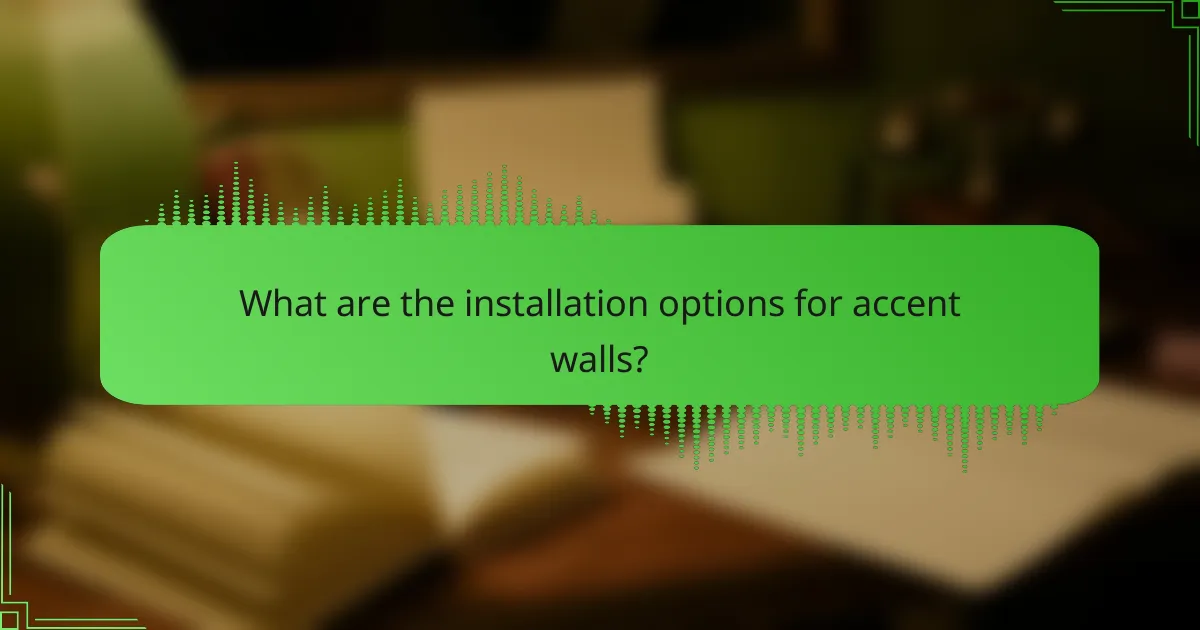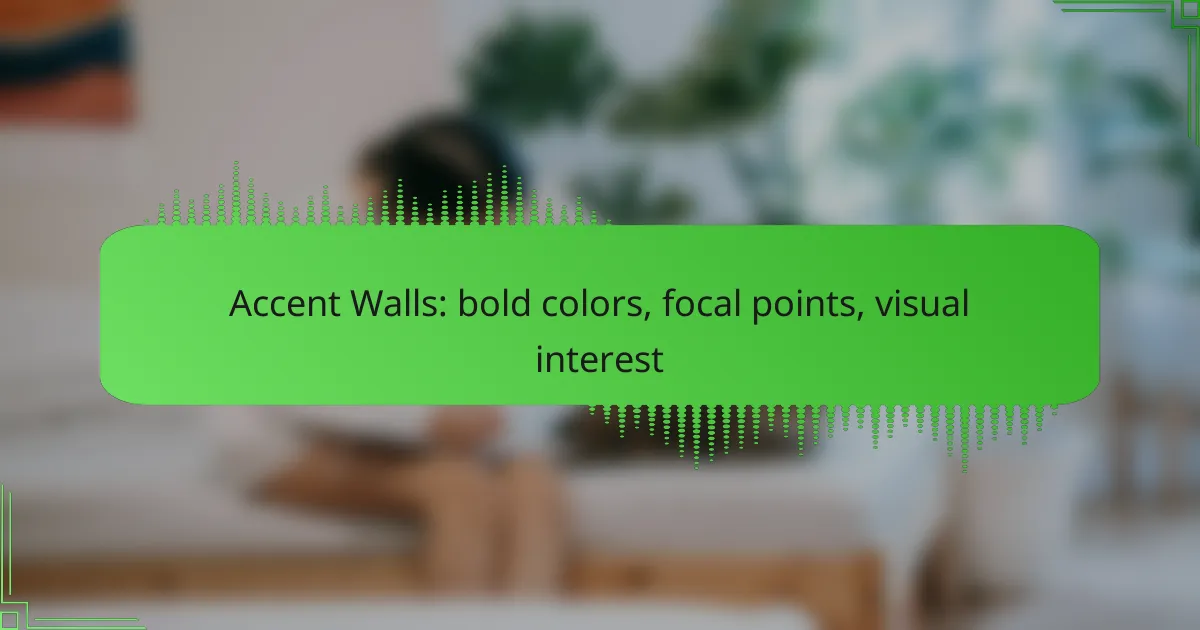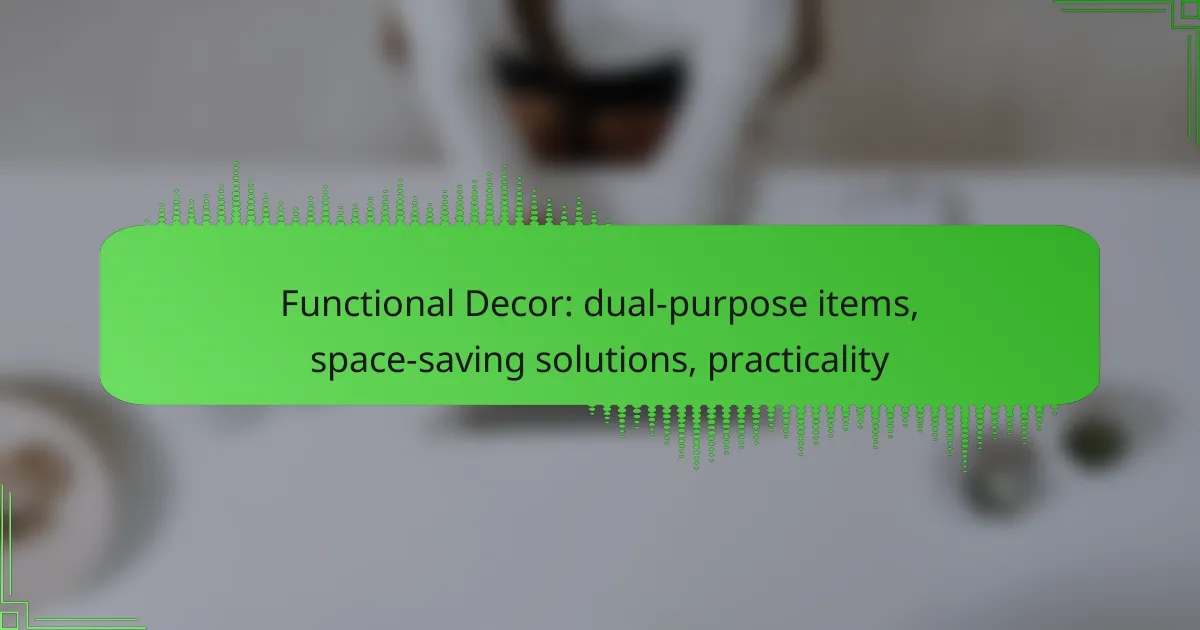Accent walls are a powerful design tool that can introduce bold colors and create striking focal points within a room. By carefully selecting hues that complement the overall color scheme and evoke desired emotions, you can enhance visual interest and transform your space. Whether using paint, wood paneling, or wallpaper, the right material will help you achieve your design goals while adding depth and character to your home.

How to choose bold colors for accent walls?
Choosing bold colors for accent walls involves selecting hues that create a striking focal point in a room. Consider the overall color scheme, the room’s purpose, and the emotions you want to evoke with the chosen colors.
Color psychology insights
Color psychology plays a significant role in how bold colors affect mood and perception. For instance, red can evoke energy and passion, while blue often promotes calmness and tranquility. Understanding these associations helps in selecting colors that align with the desired atmosphere of the space.
Additionally, warm colors like yellows and oranges can create a welcoming and cheerful environment, making them ideal for social spaces. In contrast, cooler shades may be better suited for areas meant for relaxation, such as bedrooms or reading nooks.
Popular color palettes
Some popular color palettes for accent walls include combinations like navy blue with gold, deep green with cream, or charcoal gray with bright yellow. These pairings not only enhance the boldness of the accent color but also create a cohesive look throughout the room.
When selecting a palette, consider using a color wheel to find complementary or analogous colors that work well together. This can help ensure that the bold accent wall harmonizes with the rest of the decor.
Complementary color strategies
To effectively use complementary colors, choose a bold accent color and pair it with its opposite on the color wheel. For example, a vibrant orange accent wall can be beautifully complemented by blue decor elements. This contrast can draw attention and create visual interest.
Another strategy is to use varying shades of the same color family. A deep burgundy accent wall can be paired with lighter pinks and reds in furnishings or artwork, providing depth while maintaining a unified look. Always test paint samples in the space to see how they interact with lighting and existing colors.

What are the best materials for accent walls?
The best materials for accent walls include paint, wood paneling, and wallpaper, each offering unique aesthetics and practical benefits. Choosing the right material depends on your design goals, budget, and the overall ambiance you want to create in the space.
Paint options
Paint is one of the most versatile and cost-effective choices for accent walls. You can select bold colors or unique finishes like matte, satin, or gloss to create a striking focal point. Consider using high-quality paint that offers good coverage and durability, especially in high-traffic areas.
When choosing paint, think about the room’s lighting and how different colors may appear throughout the day. For example, warm tones can make a space feel cozy, while cool tones can create a calming effect. Test samples on the wall before committing to a final color.
Wood paneling choices
Wood paneling adds warmth and texture to an accent wall, making it a popular choice for both modern and traditional interiors. Options range from reclaimed wood for a rustic look to sleek, contemporary panels that can be stained or painted. Consider the type of wood and finish that best complements your existing decor.
Installation can vary in complexity, so assess whether you want a DIY project or prefer hiring a professional. Keep in mind that wood may require maintenance, such as sealing or staining, to preserve its appearance over time.
Wallpaper selections
Wallpaper offers endless design possibilities for accent walls, from bold patterns to subtle textures. It can transform a space dramatically and is available in various materials, including vinyl, fabric, and paper. Choose a wallpaper that aligns with your style and is suitable for the room’s humidity levels, especially in kitchens or bathrooms.
When applying wallpaper, proper preparation is crucial for a smooth finish. Ensure the wall is clean and primed, and consider hiring a professional for intricate patterns or large areas. Removable wallpaper is also an option for renters or those who like to change their decor frequently.

How to create focal points with accent walls?
Creating focal points with accent walls involves strategically using bold colors or patterns to draw attention to specific areas in a room. This technique enhances visual interest and can transform an ordinary space into a dynamic environment.
Design layout techniques
When designing an accent wall, consider its placement in relation to the room’s layout. Position the wall behind key furniture pieces, such as a sofa or bed, to naturally draw the eye. Using geometric shapes or patterns can also add depth and intrigue.
Choose colors that complement the overall color scheme of the room. For example, if your space features neutral tones, a vibrant accent wall can provide a striking contrast. Ensure the design aligns with the room’s purpose; a calming hue may suit a bedroom, while a bold shade may energize a living area.
Lighting considerations
Lighting plays a crucial role in highlighting an accent wall. Natural light can enhance the vibrancy of bold colors, so consider the wall’s orientation and window placement. For artificial lighting, use spotlights or wall sconces to create dramatic effects.
Adjust the brightness of your lighting to match the mood you want to set. Warmer lights can soften the look of a bold color, while cooler lights can make it appear more striking. Experiment with different lighting angles to find the most flattering effect.
Furniture arrangement tips
Arranging furniture around an accent wall can enhance its impact. Position larger pieces, like sofas or bookshelves, at angles that face the wall to create a natural flow. This arrangement encourages conversation and draws attention to the accent color.
Be mindful of scale and proportion. Avoid overcrowding the area with too many items, as this can detract from the accent wall’s effect. Instead, use complementary decor, such as artwork or plants, to enhance the focal point without overwhelming it.

What are the trends in accent wall designs for 2023?
In 2023, accent wall designs focus on bold colors, unique textures, and sustainable materials to create striking focal points in living spaces. Homeowners are increasingly looking for ways to add visual interest and personality to their interiors through innovative design choices.
Textured wall treatments
Textured wall treatments are gaining popularity as they add depth and character to accent walls. Options like reclaimed wood panels, 3D wall tiles, and plaster finishes can transform a simple wall into a stunning feature. Consider using materials that complement your existing decor while providing a tactile experience.
When selecting textured treatments, think about the overall ambiance you want to create. For a cozy feel, opt for warm wood tones; for a modern look, consider sleek metal or stone finishes. Ensure the texture aligns with your room’s purpose, as a playful texture may be more suitable for a child’s room than a formal living area.
Geometric patterns
Geometric patterns are a bold choice for accent walls, offering a modern twist to traditional designs. These patterns can be achieved through paint, wallpaper, or decals, allowing for flexibility in style and application. Popular shapes include triangles, hexagons, and chevrons, which can create visual intrigue and movement.
When implementing geometric designs, choose a color palette that harmonizes with the rest of the room. A combination of contrasting colors can make the pattern pop, while a monochromatic scheme can create a more subtle effect. Be mindful of scale; larger patterns work well in spacious areas, while smaller designs are better suited for compact spaces.
Eco-friendly materials
Eco-friendly materials are increasingly favored in accent wall designs, reflecting a growing awareness of sustainability. Options such as bamboo, reclaimed wood, and recycled metal not only enhance aesthetics but also contribute to a healthier environment. These materials often come with lower carbon footprints and can be sourced locally, reducing transportation impacts.
When choosing eco-friendly options, look for certifications like FSC (Forest Stewardship Council) for wood products or low-VOC (volatile organic compounds) paints. This ensures that your accent wall is not only stylish but also safe for indoor air quality. Incorporating these materials can also resonate with environmentally conscious buyers if you plan to sell your home in the future.

How to measure and plan for an accent wall?
Measuring and planning for an accent wall involves determining the wall’s dimensions, calculating the materials needed, and budgeting for installation. This process ensures you achieve the desired visual impact while staying within your resources.
Measuring wall dimensions
Start by measuring the height and width of the wall where you plan to create the accent. Use a tape measure for accuracy, and record the dimensions in feet or meters. If the wall has windows or doors, measure their dimensions as well to account for them in your planning.
Consider the layout of the room and how the accent wall will interact with other elements, such as furniture and decor. A well-measured wall can enhance the overall aesthetic and create a focal point that draws attention.
Calculating material needs
Once you have the wall dimensions, calculate the square footage to determine how much paint or wallpaper you will need. For paint, multiply the height by the width of the wall, then subtract the area of any windows or doors. A gallon of paint typically covers around 350 to 400 square feet.
If you’re using wallpaper, check the roll coverage, which usually ranges from 30 to 60 square feet per roll. Always purchase a little extra to account for mistakes or pattern matching, generally around 10% more than your calculated need.
Budgeting for installation
Budgeting for your accent wall involves estimating costs for materials and labor. Paint costs can vary, but expect to spend anywhere from $20 to $60 per gallon, while wallpaper can range from $15 to $100 per roll, depending on the design and quality.
If you plan to hire a professional for installation, labor costs can add significantly to your budget. Rates often range from $25 to $75 per hour, depending on your location and the complexity of the job. Always get multiple quotes to ensure competitive pricing.

What are the installation options for accent walls?
Accent walls can be installed through various methods, primarily DIY or by hiring professionals. Each option has its advantages and considerations, depending on your skill level, budget, and desired outcome.
DIY installation steps
To install an accent wall yourself, start by selecting your materials, such as paint, wallpaper, or wood panels. Prepare the wall by cleaning it and patching any holes, then measure and cut your materials to fit the space accurately.
Next, apply your chosen material according to the manufacturer’s instructions. For paint, use painter’s tape to create clean edges, and consider using a primer for better color adherence. Allow adequate drying time before adding a second coat if necessary.
Finally, step back to assess your work, making any touch-ups as needed. Common pitfalls include misalignment and insufficient drying time, so take your time to ensure a polished finish.
Hiring professional services
If you prefer a hassle-free approach, hiring professionals can ensure a high-quality installation. Look for local contractors who specialize in accent walls and check their reviews and portfolios to find a suitable match for your style.
When hiring, discuss your vision and budget upfront. Professional services may cost anywhere from a few hundred to several thousand dollars, depending on the complexity and materials used. Ensure you understand what is included in the quote, such as preparation work and cleanup.
After hiring, maintain communication with your contractor throughout the process to ensure the project aligns with your expectations. This collaborative approach can help avoid misunderstandings and ensure a successful outcome.



